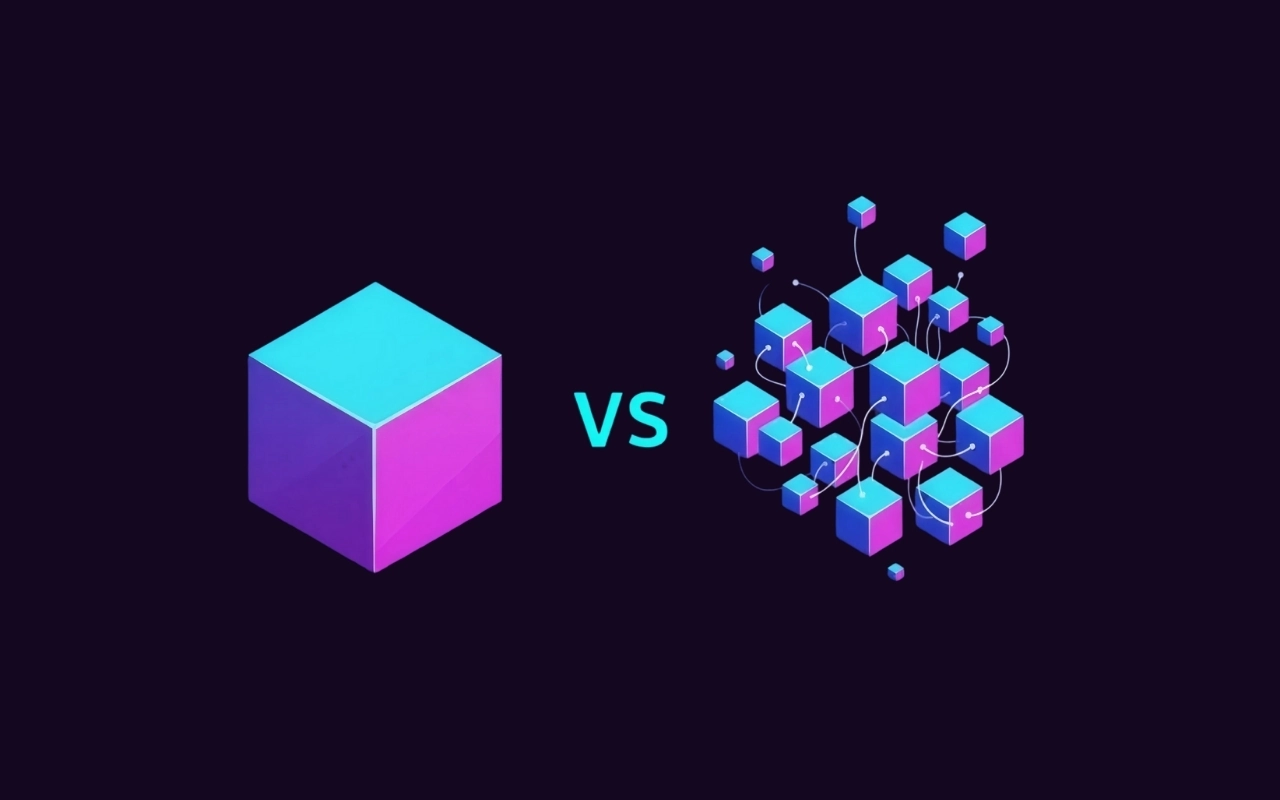Say you just joined a tech company and you are asked to set up the foundation for its entire stack. You have plenty of choices to make but one decision carries more long term weight than it first seems. Do you build the product as a monolith or break it into microservices?
On the surface it looks like a simple fork in the road.
But in reality this choice shapes how fast your team ships, how the product grows, how complex your operations become, and how much stress your engineers deal with on an average week.
Pick the wrong one too early and you will have to spend months trying to fix problems you didn’t need to create. It impacts your burn rate and your ability to pivot when the market changes.
So which path makes sense then?
Before picking a side let’s get a clear understanding of what each approach really is and what it means for your team.
What A Monolith Really Is
A monolith is one full application built and deployed as a single unit. All features, logic, and data access live in just one codebase. This basically means one place to build and one place to test. When you deploy it the whole app ships together.
This monolithic architecture works well early on because it keeps everything simple. You avoid service boundaries, network calls, and extra layers of setup. Engineers can focus on building features instead of coordinating across multiple services.
Basically a monolith is a single unified system that trades flexibility for clarity and speed.
What Are Microservices Really
Microservices split the product into many small and independent services. Each service handles one clear function which runs on its own and can be deployed without touching the others.
Instead of one large app you now have a group of smaller apps talking over a network. This gives more flexibility and helps when different parts of your system grow at different speeds. But it also adds more moving parts, more monitoring, more alerts, and more operational work.
A real life example for this is companies like Netflix and Uber. They started off with a monolithic architecture but switched to microservices as their business grew. By breaking their application into smaller independent services they were able to scale better and provide stronger user experiences as they expanded globally.
This means that microservices are separate services that give you modularity but also raise the operational load.
Why Most Teams Should Start With A Monolith
People don’t say this enough but most products should begin as a monolith. For about 90 percent of early stage teams it is the simplest and most stable way to get work done.
Here is why.
1. You Build Faster
One codebase keeps things light. You ship features without worrying about service boundaries or cross-service calls. You focus on the product logic rather than the network logic.
2. It Keeps Costs Under Control
Microservices demand strong pipelines, more compute power, and deep observability. A monolith avoids those costs until they are absolutely needed.
3. Debugging Is More Direct
You don’t have to chase a bug across several services. Logs live in one place and behavior is consistent. This saves your developers hours of frustration.
4. New Teams Need Clarity
A monolith gives everyone the same structure. Early teams move faster when the system is simple and easy to understand.
When A Monolith Starts To Strain
A monolith works well until it doesn’t. You will know it is time to reconsider your structure when you feel specific pains that show up often and slow real progress.
Team Pain
If teams block each other every week and releases slow down because they are all touching the same parts of the codebase your monolith might be too tight for your current team size.
Scaling Pain
This is where modern tech like AI and automation often force the issue.
Say your application has a core feature but you also added an AI-driven recommendation engine. That AI component might need heavy GPU power while the rest of your app just needs standard CPU. If you stay monolithic you have to scale the entire massive application just to support that one AI feature. That is a waste of money.
If one part of the app hogs all the resources and starves the rest it is a sign you need to split that piece out.
Reliability Pain
If a small issue can take down the full product you may need separation between features that a monolith can’t provide anymore. The “forgot password” function should not be able to crash your entire checkout process.
The Real Cost Of Microservices
This is where most teams underestimate the move. Microservices are not a light refactor. They change how your entire system runs.
Here is what you take on.
Many Services To Maintain:
Ten or more services is common. Each has its own deploy steps, logs, alerts, and failure paths. Someone has to manage all of that.
Debugging Gets Slower:
Failures spread across services. A slow call or timeout creates noise in places you don’t expect. You need strong tools and habits to track it.
Data Becomes More Complex:
You now juggle several data stores or sync logic. Both add overhead and risk.
You Need A Mature Ops Setup:
You need good pipelines, steady alerting, and clear ownership. If your team isn’t ready, microservices will highlight every gap in your process.
Feature Delivery Slows At First:
Teams don’t speed up right away. The overhead takes time to settle before you see gains.
Quick Comparison Table

So When Should You Switch?
The hardest part of this decision is simple. Switching too early creates more problems than it solves.
A clean rule of thumb is to switch only when the pain of staying in the monolith is worse than the cost of running microservices.
You should not switch because:
- It feels old
- You saw another company do it
- A post made it sound promising
You switch when:
- Teams block each other every week
- Scaling the whole app is wasteful
- Small issues take out too much
- Your ops setup is mature and steady
- You have the budget and skills to support the move
A Note on AI and Automation
Modern workloads like AI-driven workflows or marketing tech tooling often behave very differently from typical product features. They may require specialized compute or handle large volumes of data which can put pressure on a coupled monolith.
If running AI models or automation jobs starts slowing down your core application that is a strong signal you may need more modular boundaries. This doesn’t always mean a full microservices migration. Many teams simply extract AI or automation features into their own service while keeping the rest of the product monolithic.
How To Extend The Life Of Your Monolith
Here are simple ways to keep your monolith useful for longer.
- Keep Internal Boundaries Clean: This makes day to day work easier and helps if you later extract services.
- Use Feature Flags: They reduce merge stress and help teams test without stepping on each other.
- Offload Heavy Workloads: If one task needs special treatment you can move only that part out without a full rewrite.
- Assign Ownership: Even with one codebase, clear ownership helps teams move faster.
The Bottom Line
Microservices are not a badge of growth. They are a tool for specific problems. If you don’t have those problems yet the move slows you down.
A monolith is a stable and simple place to begin. Keep it clean, watch for real pain, and make the switch only when the business needs it. Do not switch just because the industry talks about it.
If you are unsure whether your product architecture should stay monolithic or move towards microservices or if you need help scaling your system the right way we can help you evaluate your options.
Reach out today and let’s figure out the best path forward for your business.




